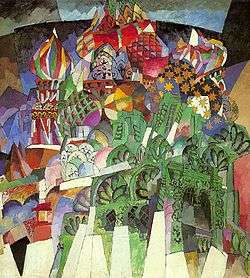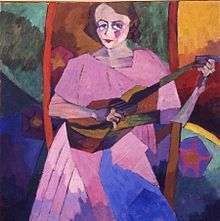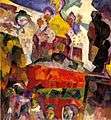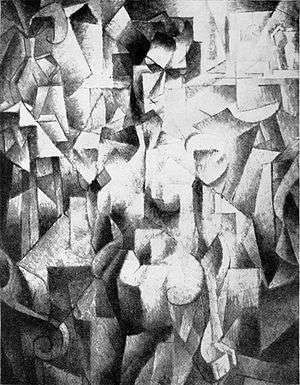Aristarkh Lentulov
| Aristarkh Lentulov | |
|---|---|
.jpg) Aristarkh Vasilyevich Lentulov, c.1930 | |
| Born |
January 16, 1882 Nizhny Lomov, Penza Gubernia, Russian Empire |
| Died |
April 15, 1943 Moscow |
| Nationality | Russian |
| Known for | Painter |
| Movement | Post-Impressionism, Fauvism, Cubism, Orphism, Cubo-Futurism |

Aristarkh Vasilyevich Lentulov (Russian: Лентулов, Аристарх Васильевич) (January 16, 1882 - April 15, 1943) was a major Russian avant-garde artist of Cubist orientation who also worked on set designs for the theatre.
Biography
Aristarkh Lentulov was born in the town of Nizhny Lomov in Penza Oblast, Russia into the family of a rural priest. He studied art in the Penza and Kiev art schools from 1897 to 1905, and then in the private studio of Dmitry Kardovsky in Saint Petersburg in 1906.
He lived in Moscow from 1909, and he was one of the founders of the avant-garde exhibiting association of artists, the Jack of Diamonds group. This group remained active until its dissolution in 1916.
From 1910 to 1911 Lentulov studied at the studio of Henri Le Fauconnier and the Académie de La Palette in Paris. The 1910s were for Lentulov a period of creative productivity and experimentation. He was drawn to Orphism influenced by the French artist Robert Delaunay. Whilst there, he became acquainted with contemporary French painters such as Albert Gleizes, Jean Metzinger, Fernand Léger and Robert Delaunay and after absorbing fauvists' and cubists' principles, developed his own unique coulorful style of painting. Later, after his return to Russia in 1912 he became a major influence on what to become the Russian futurism and in particular Cubo-Futurism. Wassily Kandinsky and Kazimir Malevich were both influenced by him.
Lentulov also formed another group, with Vladimir Mayakovsky and Kazimir Malevich, called Today's Lubock (Segodnyashnii Lubok). They produced satire art that was anti-Austria and anti-Germany. The art pulled inspiration from Russian folklore and lubok art. Lentulov's own art was heavily inspired by traditional and folk Russian architecture.[1]
From pre-revolutionary times, Lentulov was actively involved in various theatrical projects, designing for plays in the Kamerny Theatre (The Merry Wives of Windsor, 1916) and contributing sets for a production of Scriabin's Prometheus in the Bolshoi Theatre in 1919.
In 1928 Lentulov entered into the Society of Moscow artists, which included artists formerly associated with the Jack of Diamonds group. He became chairman of the Society and also started teaching at the Russian state art and technical school (VKhUTEMAS).
Lentulov died in Moscow and is buried in the Vagankovo Cemetery.
Works
| Wikimedia Commons has media related to Aristarkh Lentulov. |
- Saint Basil's Cathedral, 1913, Tretyakov Gallery, Moscow.
- Ringing, 1913, GTG
- Moscow, 1913, GTG;
- In The iverskoy, 1916, GTG;
- View with the red house, 1917;
- Churches. New Jerusalem , 1917;
- Self-portrait with the violin
- Portrait A. 4. Tairova. 1920;
- The cracking of petroleum refinery, 1931, GTG;
- Night on the patriarch ponds, 1928, GTG;
- Passionate area at night, 1928, GRM
- Sunset in the Volga, 1928;
- The sun above the roofs. Rise, 1928;
- Vegetables, 1933, GTG
- Building of the metro over the Lubyanka area, 1936, GTG;
-

Skybell (Nebozvon)
-

Woman with Guitar, 1913
-

Portrait of Artist's Wife and Daughter, 1915
-

Tverskoi Boulevard , 1917
See also
Bibliography
- Lentulova M., Khudozhnik A. Lentulov. Recollections. M., 1969.
- Aristarkh Lentulov. Catalog of exhibition, M., 1968
References
- ↑ "The Austrians Surrendered Lvov to the Russians, Like Rabbits Defeated by Lions". World Digital Library. 1914. Retrieved 2013-09-29.
External links
- Artcyclopedia Links to Lentulov's works
- Aristarkh Vasilyevich Lentulov ENCYCLOPÆDIA BRITANNICA


.jpg)